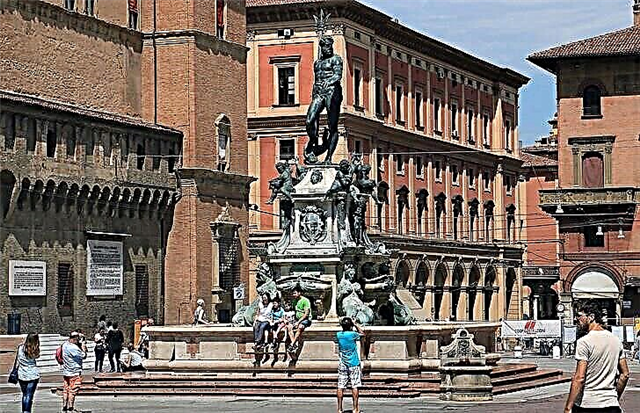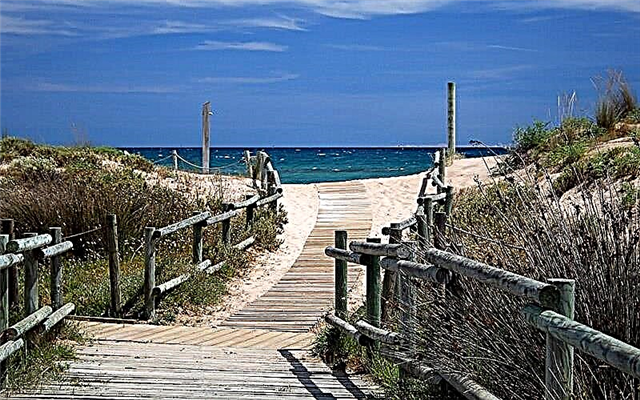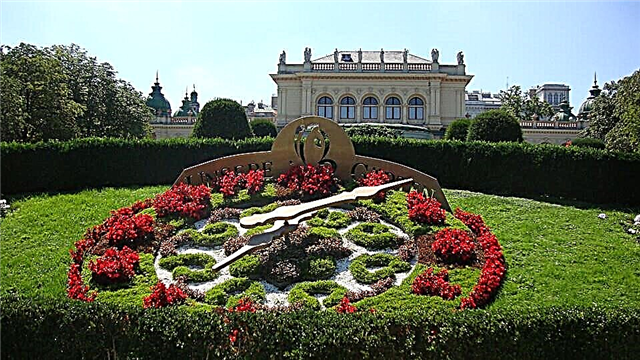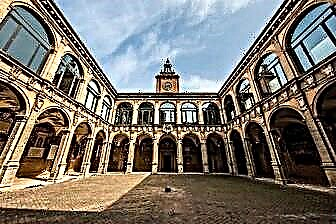Among the picturesque hills of the Padan Plain in the blessed region of Emilia-Romagna, Bologna is located - one of the most prosperous Italian cities, the culinary capital of the country and the birthplace of the oldest European university. The historic center of Bologna is full of palaces, temples and quarters built during the Early Middle Ages and well preserved thanks to timely renovations.
Once upon a time the great Copernicus and Dante wandered the streets of the city, chefs diligently invented a new type of pasta and sauce especially for the wedding of Lucrezia Borgia, and the founder of the ancient Dominican Order read his sermons to a grateful flock. History itself was created in Bologna, whose secrets have been carefully preserved here for many centuries.

The best hotels and hotels at affordable prices.
from 500 rubles / day
What to see and where to go in Bologna?
The most interesting and beautiful places for walking. Photos and a short description.
Maggiore and Neptune squares
Piazza Maggiore is the central square of Bologna, which was formed in the 13th century. Initially, the city market was located here. The place was fully equipped by the 16th century. Around the square are the Palazzo Podesta, Palazzo Commune, the Basilica of St. Petronius (San Petronio) and other historic buildings. Piazza Neptune is bordered by Maggiore in the northwest. It owes its name to the fountain of the same name with a bronze statue of the god, which was created in 1567.

Fountain of Neptune
An interesting story is connected with the fountain and the sculpture of Neptune. The statue was created by a Flemish craftsman nicknamed Giambologna in 1567. The work was not liked by the Catholic clergy, as they felt that nudity would embarrass the residents. The clergy suggested that the sculptor wear trousers on Neptune. As a result, it was decided to ask the townspeople themselves and hold a referendum on the need to "cover up the shame." But the inhabitants of Bologna decided to leave everything as it is, and now the masterpiece adorns the square.

University Palace
The University of Bologna is the oldest and one of the most respected in Europe. The first faculties were formed here already in the 11th century. Among the outstanding graduates of the educational institution are Dante, Petrarch and Copernicus. Until the 16th century, the departments of the university were located in several separate buildings, until Pope Pius IV ordered the construction of the Archigimnasium - the University Palace, which still adorns the architecture of Bologna.

Anatomical theater
The theater is located in one of the former buildings of the University of Bologna. It arose in 1637 after the Church's ban on medical autopsy was lifted. Previously, the theater was used as a showroom for medical students, now sometimes performances are shown here (in one way or another related to anatomy). The original building was destroyed in 1944. Only wooden sculptures survived, which now adorn the restored theater.

Asinelli and Garisenda Towers
Medieval buildings located near the Basilica of St. Petronius. It is believed that they were built at the beginning of the 12th century. The Asinelli Tower is 97 meters high and has an inclination of 1.3 ° towards the base. Garisenda is significantly inferior in size, its height is 48 meters. The structures served both as housing and a defensive fortress. In the 20th century, a military observation post and a TV tower were located in Asinelli.

Independence street
The alley stretches from the central city station to the main square of Maggiore. Along the street there are city mansions with through arched galleries. An incredible number of shops of various price categories, coffee shops and restaurants of Italian cuisine are concentrated here. The street is perfect for leisurely walks, quality shopping and exploring the city.

Palazzo Comunale
The palace complex is located in Piazza Maggiore. It appeared in the XII century thanks to the unification of individual buildings into a single architectural ensemble. Since 1336, the palazzo has been used as the seat of the city administration. The palace also houses the Giorgio Morandi Museum, where paintings of the 20th century are exhibited. The interiors of Palazzo Comunale are decorated with decorative elements and frescoes from the 15th - 16th centuries.

Palazzo Re Enzo
The building of the palace was erected in the XIII century for the needs of the city administration. The name "Re Enzo" comes from the famous prisoner of the castle - the ruler of Sardinia, Enzo, who spent more than 20 years in prison here. There is a legend that his illegitimate son, conceived in the palace, laid the foundation for the family of the rulers of Bologna. Palazzo Re Enzo underwent two major renovations in the 18th and 20th centuries.

Palazzo Podesta
The palace was erected in 1200 for the head of the city administration (podestà). Initially, the interior was made in the Gothic style, but the 15th century Renaissance decoration has survived to this day. On the territory of the arched gallery, which occupies the entire first floor, there are retail premises. The Palazzo Podesta is crowned with a square crenellated tower. Access inside is only possible during events.

Palazzo della Mercancia
The palace houses the Bologna Chamber of Commerce and Industry. The building was erected at the end of the XIV century in the style of "Italian" Gothic. Until 1811, it housed the representatives of the trade guilds and the merchants' court. The palazzo is built of red bricks, adorned with elaborate frescoes and marble finishes. During the Second World War, as a result of the bombing, the facade was destroyed, which was restored by 1949.

Izolani House
Three-storey residential building from the 13th century, located about 300 meters from Plaza Maggiore. It is a valuable example of civil architecture at the intersection of the Romanesque and Gothic styles. A covered walkway leads from the Izolani house to the Izolani Palace, built in the 15th century. This palazzo already has the distinct features of the Italian Renaissance.

City Archaeological Museum
The museum was founded in 1881. Its history began with an exhibition of archaeological finds in 1871, which was opened on the territory of the Archimnasium. Later, the collection was transferred to the Galvani Palace, specially restored for this purpose. The museum exposition is divided into eight sections, which represent different historical periods. Many of the exhibits were borrowed from the collection of the University of Bologna.

Palazzo Poggi Museum
Museum of the University of Bologna, which brings together several collections. The exposition is located on the territory of the palace complex in the Renaissance style. Since 1711, the Scientific Institute with an astronomical observatory was located in Palazzo Poggi. In museums, you can admire the collection of old geographical maps, picturesque frescoes, a unique collection of the naturalist U. Aldrovandi and much more.

Medieval Museum
The collection is located on the territory of the Gizilardi Palace of the 15th century. The exposition is based on the private collection of General L.F. Marsili, aristocrat F. Cospi and painter P. Palaggi. The museum contains various exhibits, which can be used to get an idea of how medieval Bologna lived. There are statues, stained glass windows, bas-reliefs, church vestments, gravestones and other interesting artifacts.

Museum of the History of Bologna
The exposition was opened in 2012. She settled in the Pepoli palace. Now the museum is at the stage of active fundraising. Interactive installations are available for visitors, with the help of which models of medieval streets and buildings are created. Some of the exhibits are presented from a very interesting perspective using modern technology. The museum collection is located in 34 rooms.

National Pinacoteca of Bologna
City Museum of Art, housed in a building formerly owned by the Jesuit Order. The Pinakothek collection mainly consists of works by Italian artists of the 13th-18th centuries. It is believed that the gallery was founded in the 18th century thanks to Cardinal Prospero Lambertini, who later became Pope and became known as Benedict XIV. In 1796, the exhibits were confiscated from the churchmen and transferred to the municipal museum.

Opera House Komunale
The building of the theater began to be erected according to the project of A. Galli in the 18th century, construction work continued until the 1930s, despite the fact that the stage was inaugurated in 1651. Reconstruction was carried out in 1981. Operas by Rossini, Bellini, Wagner and Verdi were staged on the stage of the Comunale Theater. Nowadays, the repertoire consists of all the same classical pieces loved by the public.

Salabors Library
Since 2001, the book collection has been located in Palazzo d'Accursio, which is located in the main square of Maggiore. The library halls are well equipped and technically equipped. Particular attention is drawn to the children's room, where you can borrow books written in various languages. The courtyard of Salaborsa is surrounded by a series of arched galleries and covered with a picturesque glass dome.

Mercato di mezzo market
The place is popular not only among tourists, but also among the residents of Bologna, as here you can have an inexpensive meal of delicious delicacies and drink a couple of glasses of excellent Italian wine. Local cheeses, various varieties of prosciutto, pastries, fish and other products are placed on small market stalls. Due to the large number of people, it is often crowded here and there are not always enough tables for everyone.

Santo Stefano
A complex of religious buildings located on the square of the same name. The temples of the complex belong to the period of the Early Middle Ages - from the 5th to the 12th century. The structures were built in such a way as to replicate the outlines of the Jerusalem temples known and revered in the Christian world. The complex was restored in the 19th-20th centuries, after which it acquired a modern look.

Church of Madonna di San Luca
The history of the temple began in the 12th century with the construction of a small church. In the XV-XVIII centuries. the building was rebuilt several times, the features of the Baroque and Renaissance were introduced into its architectural appearance. The final construction work was completed only in the 20th century. The basilica is the center of pilgrimage, as it houses a Christian shrine - the icon of the Virgin Mary with Jesus. It is believed that it was created by the evangelist Saint Luke, who lived in the 1st century.

Basilica of San Petronio
The old cathedral of Bologna, located in the main square of Maggiore. The construction of the temple continued in the period 1390-1663. It is considered the fifth largest in Europe (45 meters high, 132 meters long, 60 meters wide). The temple was erected in honor of Saint Petronius, who was Bologna bishop in the 5th century. He is considered the patron saint of the city. The interior of the cathedral is decorated with valuable works of art created in the XII-XV centuries.

Basilica of San Domenico
The church houses the remains of St. Dominic, the founder of the Dominican Order, so it is the main shrine for the representatives of this association. Such masters as Michelangelo, N. Pisano and A. Di Cambio worked on the magnificent marble tomb of St. Dominic. The basilica also houses the organ that V.A. Mozart during his life in Bologna.

Cathedral of Saint Peter
Bologna's main cathedral, built at the end of the 12th century in the Romanesque style and rebuilt in the 13th century in the Gothic style. The main bell tower and crypt were created in the 16th century by D. Tybaldi. Further restructuring under the direction of various architects has already been carried out in the Baroque style. There is a museum at the temple, where various items of church utensils are displayed.

Certosa cemetery
The necropolis has been functioning since 1801. It was created on the outskirts of Bologna on the territory of a former monastery, which was dissolved in 1796. Within the cemetery are the mass graves of the soldiers of the First and Second World Wars. Certosa also contains the graves of the famous singer Farinelli, writer R. Bakelli, singer L. Dalla and other personalities who contributed to the development of Italian culture.












